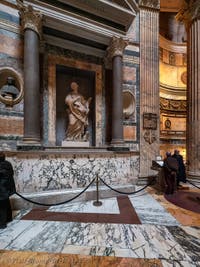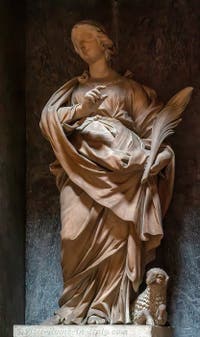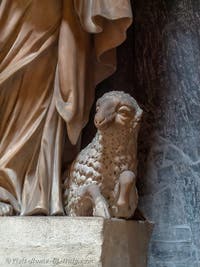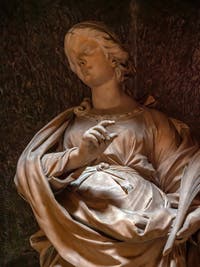Pantheon Art Story | Location | Opening Hours Tickets | Authorisations
Art Story Story | Porch Rotunda | Cupola | Basilica | Chapels Tombs
Chapels 1st Chapel | King Umberto I | 3rd Chapel | 4th Chapel | 5th Chapel | Vittorio Emanuele II | 7th Chapelle
Aediculas 1st Aedicula | 2nd Aedicula | Raphael Tomb | 4th Aedicula | 5th Aedicula | 6th Aedicula | 7th Aedicula | 8th Aedicula
Second Aedicula of the Pantheon Basilica in Rome “Saint Agnes”
In addition to his “Saint Agnes”, Vincenzo Felici is also known for sculpting one of the statues in Santa Maria in Trastevere representing the pope.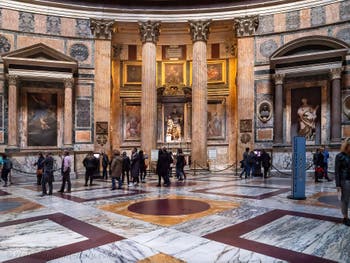
Felici, Saint Agnes Saint Agnes of Rome was a virgin martyr born in 291 and died in 305.
Her life and martyrdom are part of the “Latin Passions.”
Among his attributes, Vincenzo Felici has included his palm of martyrdom and a white lamb.
The name Agnes, Agnos in Greek, means chaste and pure.
She is the patron saint of maidens, harvests, chastity, and scout guides.
Tradition indicates that Agnes was executed and slaughtered in the current crypt of the Church of Saint Agnes in Agone in Piazza Navona in Rome.
Vincenzo Felici (1657 — January 9, 1715) “Saint Agnes”
Sculpture - Marble, End of the 17th centuryChapels 1st Chapel | King Umberto I | 3rd Chapel | 4th Chapel | 5th Chapel | Vittorio Emanuele II | 7th Chapelle
Aediculas 1st Aedicula | 2nd Aedicula | Raphael Tomb | 4th Aedicula | 5th Aedicula | 6th Aedicula | 7th Aedicula | 8th Aedicula
Art Story Story | Porch Rotunda | Cupola | Basilica | Chapels Tombs
Pantheon Art Story | Location | Opening Hours Tickets | Authorisations
Back to Top of Page


